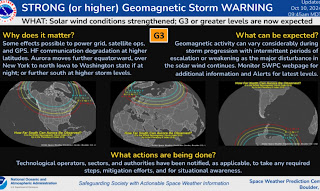Aurora Borealis
Over the past week, auroras have danced in the sky, with visibility as far south in the US as Texas and New Mexico. We have had excellent viewing opportunities in the dark skies of the North Carolina Blue Ridge Mountains.
Indigenous societies have interpreted these sky-lights in various ways. But what do modern scientists say?
Solar Cycle 25 is approaching Solar Maximum, a period in the approximate 11-year cycle when we will see intense, stormy Sun activity. Once the maximum is reached, the north and south magnetic fields of our star will flip, and the Sun’s activity will gradually slow to a “solar minimum.”
The Space Weather Prediction Center, a National Oceanic and Atmospheric Administrations (NOAA) branch, actively tracks the science behind solar events. Daily information regarding the number and intensity of solar flares, coronal mass ejections (CME), and the aurora forecast is available at the above link: you can click on the individual areas and watch their progression.
Traditional telescope studies of the Sun are now aided by the GOES-19 satellite (Geostationary Operational Environmental Satellite), which was launched on June 25, 2024.
Scientists can now issue warnings for potential earth-directed CME, which could impact communications, power grids, GPS services, and satellites. One such warning was transmitted on October 12, 2024.
The greatest recorded solar storm, the Carrington Event, occurred in 1859. With today’s reliance on electricity and technology, a CME of equivalent or greater intensity could have devastating effects.
In the interim, as our star bursts with flares and magnetic storms, we are gifted with beautiful sights: dancing red, purple, and green energy waves.
Were you able to see any aurora? Some aurora look like flames, others like pillars. The above photos were captured with my iPhone, not expensive camera gear. You, too, can get great shots with a bit of practice.












Comments
Post a Comment